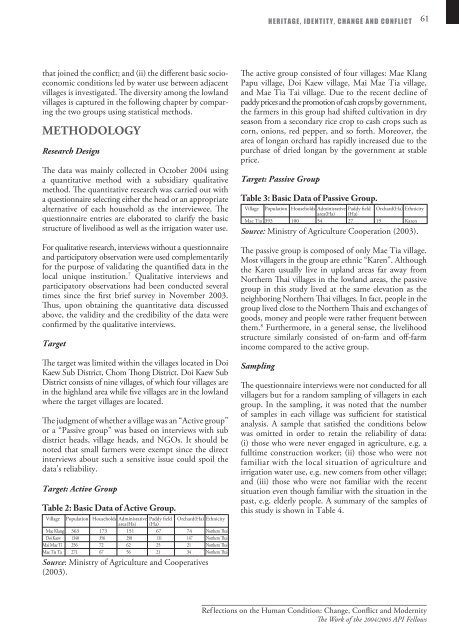Reflections on the Human Condition - Api-fellowships.org
Reflections on the Human Condition - Api-fellowships.org
Reflections on the Human Condition - Api-fellowships.org
You also want an ePaper? Increase the reach of your titles
YUMPU automatically turns print PDFs into web optimized ePapers that Google loves.
that joined <strong>the</strong> c<strong>on</strong>flict; and (ii) <strong>the</strong> different basic socioec<strong>on</strong>omic<br />
c<strong>on</strong>diti<strong>on</strong>s led by water use between adjacent<br />
villages is investigated. The diversity am<strong>on</strong>g <strong>the</strong> lowland<br />
villages is captured in <strong>the</strong> following chapter by comparing<br />
<strong>the</strong> two groups using statistical methods.<br />
METHODOLOGY<br />
Research Design<br />
The data was mainly collected in October 2004 using<br />
a quantitative method with a subsidiary qualitative<br />
method. The quantitative research was carried out with<br />
a questi<strong>on</strong>naire selecting ei<strong>the</strong>r <strong>the</strong> head or an appropriate<br />
alternative of each household as <strong>the</strong> interviewee. The<br />
questi<strong>on</strong>naire entries are elaborated to clarify <strong>the</strong> basic<br />
structure of livelihood as well as <strong>the</strong> irrigati<strong>on</strong> water use.<br />
For qualitative research, interviews without a questi<strong>on</strong>naire<br />
and participatory observati<strong>on</strong> were used complementarily<br />
for <strong>the</strong> purpose of validating <strong>the</strong> quantified data in <strong>the</strong><br />
local unique instituti<strong>on</strong>. 7 Qualitative interviews and<br />
participatory observati<strong>on</strong>s had been c<strong>on</strong>ducted several<br />
times since <strong>the</strong> first brief survey in November 2003.<br />
Thus, up<strong>on</strong> obtaining <strong>the</strong> quantitative data discussed<br />
above, <strong>the</strong> validity and <strong>the</strong> credibility of <strong>the</strong> data were<br />
c<strong>on</strong>firmed by <strong>the</strong> qualitative interviews.<br />
Target<br />
The target was limited within <strong>the</strong> villages located in Doi<br />
Kaew Sub District, Chom Th<strong>on</strong>g District. Doi Kaew Sub<br />
District c<strong>on</strong>sists of nine villages, of which four villages are<br />
in <strong>the</strong> highland area while five villages are in <strong>the</strong> lowland<br />
where <strong>the</strong> target villages are located.<br />
The judgment of whe<strong>the</strong>r a village was an “Active group”<br />
or a “Passive group” was based <strong>on</strong> interviews with sub<br />
district heads, village heads, and NGOs. It should be<br />
noted that small farmers were exempt since <strong>the</strong> direct<br />
interviews about such a sensitive issue could spoil <strong>the</strong><br />
data’s reliability.<br />
Target: Active Group<br />
Table 2: Basic Data of Active Group.<br />
Village Populati<strong>on</strong> Households Adminisrative Paddy field Orchard(Ha) Ethnicity<br />
area(Ha) (Ha)<br />
Mae Klang 363 173 151 67 74 Nor<strong>the</strong>rn Thai<br />
Doi Kaew 1340 356 298 131 147 Nor<strong>the</strong>rn Thai<br />
Mai Mae Ti 256 72 62 25 21 Nor<strong>the</strong>rn Thai<br />
Mae Tia Ta 271 67 56 21 34 Nor<strong>the</strong>rn Thai<br />
Source: Ministry of Agriculture and Cooperatives<br />
(2003).<br />
HERITAGE, IDENTITY, CHANGE AND CONFLICT<br />
The active group c<strong>on</strong>sisted of four villages: Mae Klang<br />
Papu village, Doi Kaew village, Mai Mae Tia village,<br />
and Mae Tia Tai village. Due to <strong>the</strong> recent decline of<br />
paddy prices and <strong>the</strong> promoti<strong>on</strong> of cash crops by government,<br />
<strong>the</strong> farmers in this group had shifted cultivati<strong>on</strong> in dry<br />
seas<strong>on</strong> from a sec<strong>on</strong>dary rice crop to cash crops such as<br />
corn, <strong>on</strong>i<strong>on</strong>s, red pepper, and so forth. Moreover, <strong>the</strong><br />
area of l<strong>on</strong>gan orchard has rapidly increased due to <strong>the</strong><br />
purchase of dried l<strong>on</strong>gan by <strong>the</strong> government at stable<br />
price.<br />
Target: Passive Group<br />
Table 3: Basic Data of Passive Group.<br />
Village Populati<strong>on</strong> Households Adminisrative Paddy field Orchard(Ha) Ethnicity<br />
area(Ha) (Ha)<br />
Mae Tia 393 100 54 27 19 Karen<br />
Source: Ministry of Agriculture Cooperati<strong>on</strong> (2003).<br />
The passive group is composed of <strong>on</strong>ly Mae Tia village.<br />
Most villagers in <strong>the</strong> group are ethnic “Karen”. Although<br />
<strong>the</strong> Karen usually live in upland areas far away from<br />
Nor<strong>the</strong>rn Thai villages in <strong>the</strong> lowland areas, <strong>the</strong> passive<br />
group in this study lived at <strong>the</strong> same elevati<strong>on</strong> as <strong>the</strong><br />
neighboring Nor<strong>the</strong>rn Thai villages. In fact, people in <strong>the</strong><br />
group lived close to <strong>the</strong> Nor<strong>the</strong>rn Thais and exchanges of<br />
goods, m<strong>on</strong>ey and people were ra<strong>the</strong>r frequent between<br />
<strong>the</strong>m. 8 Fur<strong>the</strong>rmore, in a general sense, <strong>the</strong> livelihood<br />
structure similarly c<strong>on</strong>sisted of <strong>on</strong>-farm and off-farm<br />
income compared to <strong>the</strong> active group.<br />
Sampling<br />
The questi<strong>on</strong>naire interviews were not c<strong>on</strong>ducted for all<br />
villagers but for a random sampling of villagers in each<br />
group. In <strong>the</strong> sampling, it was noted that <strong>the</strong> number<br />
of samples in each village was sufficient for statistical<br />
analysis. A sample that satisfied <strong>the</strong> c<strong>on</strong>diti<strong>on</strong>s below<br />
was omitted in order to retain <strong>the</strong> reliability of data:<br />
(i) those who were never engaged in agriculture, e.g. a<br />
fulltime c<strong>on</strong>structi<strong>on</strong> worker; (ii) those who were not<br />
familiar with <strong>the</strong> local situati<strong>on</strong> of agriculture and<br />
irrigati<strong>on</strong> water use, e.g. new comers from o<strong>the</strong>r village;<br />
and (iii) those who were not familiar with <strong>the</strong> recent<br />
situati<strong>on</strong> even though familiar with <strong>the</strong> situati<strong>on</strong> in <strong>the</strong><br />
past, e.g. elderly people. A summary of <strong>the</strong> samples of<br />
this study is shown in Table 4.<br />
Ref lecti<strong>on</strong>s <strong>on</strong> <strong>the</strong> <strong>Human</strong> C<strong>on</strong>diti<strong>on</strong>: Change, C<strong>on</strong>flict and Modernity<br />
The Work of <strong>the</strong> 2004/2005 API Fellows<br />
61

















